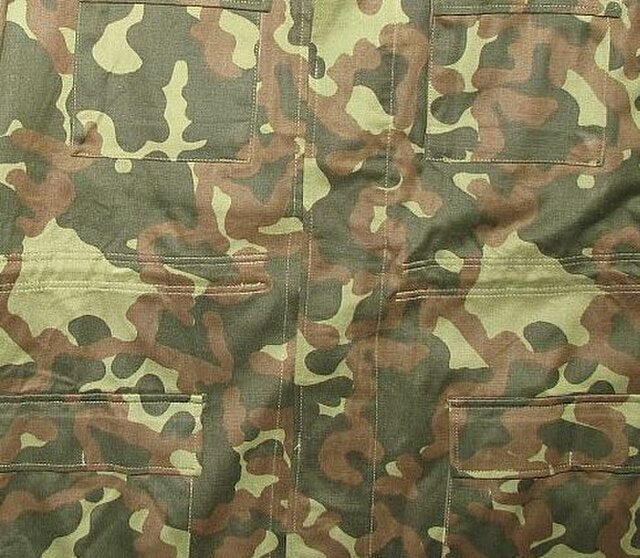From the battlefield to the bedroom, camo patterns have solidified their place in our culture. Traditional camouflage set its roots in the First World War when European men in their bright uniforms were made into tartare by advanced German weaponry.
Since then, the patterns have changed with the wars. Military camo has been designed and redesigned to fit the battlegrounds. It has also been adopted by the outdoors community, with brands like RealTree and Mossy Oak creating camouflage that is part attire and part landscape realism.
But why on earth do so many civilians wear camo? After all, only six percent of the American population hunts each year. Who could have ever imagined a time where the popularity of camo that hunters wear would outpace the activity of hunting itself? It’d be like Americans walking around with football helmets on.
Maybe not the worst idea these days. Where can you buy a level IV Philadelphia Eagles kevlar helmet?
Table of Contents
-
01
The Ancient Technology of Camouflage
-
02
Basics of Camouflage
-
03
Who are the Camouflage Innovators of Today
-
04
Hiding From Whitetails
-
05
Hiding from Humanity
-
06
Maybe Not Hiding at All
-
07
Final Thoughts on Camo Patterns
-
08
Frequently Asked Questions
The Ancient Technology of Camouflage
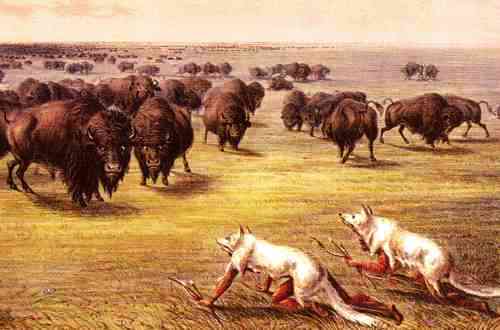
Native Americans using camouflage while hunting. (Image courtesy of warpaths2peacepipes)
Before the first World War, there was no need for concealment from long distance weaponry on the battlefield. This strange Franken-war saw the stitching together of warfighting technologies that had no business on the same battlefield. This monster had one arm from the eighteenth century and another from the twentieth.
Riding horses into battle alongside tanks, while biological weapons were being sprayed across the battlefield–not a CM-6M in sight! The standard issue battle rifles were bolt action. This war was like pulling something out of the oven that was only three quarters of the way done!
After trotting out into the killing fields with white gloves on and ghastly red pants, the French suffered serious losses and decided it was time to create the Section de Camouflage. Artists hand painted the first modern camo patterns on the soldiers' uniforms.
Imagine an artist like George Braque, who promptly put his artistic pursuits on the shelf to enter the Great War, bent over in a trench, flecking paint on uniforms to keep his fellow soldiers better concealed from German machine guns.

George Braque’s still life with grapes. (Image courtesy of Wikimedia Commons)
“On 2 August 1914, I took Braque and Derain to the station at Avignon. I never saw them again.” – Pablo Picasso, of neutral Spain, years after the war
Trading paint brushes for Lebel M1886 rifles was a valiant sacrifice. These men were changed forever, but who knows how many lives the Section de Camouflage saved?
Of course, camo patterns go back way further than the artists of WWI. Native Americans, for example, mastered hunting, in part by using paint and wolf hides to conceal themselves from enemies and animals alike.
The natural materials used by Native Americans are as old as their very presence on the continent. There is no way of knowing when they started using things like ores, fruits, roots, flowers, duck manure, and even buffalo gallstones. After all, there was no Ulta on the North American continent–yet.
Basics of Camouflage
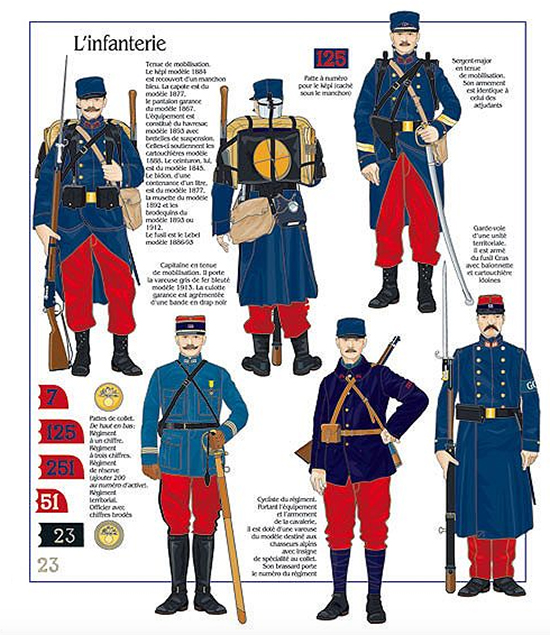
The French artists hand painted camouflage in the First World War. (Image courtesy of The Artist’s Road)
What does this collection of overlapping shapes and colors actually do? How does camouflage really work for someone trying to conceal themselves and remain concealed?
“All warfare is based on deception.”
– Sun Tzu
The deception of camouflage is all about giving the eye too much variety. Of course, this variety of colors and shapes must match the environment, or at least shades of the environment. These things work together to break up your human pattern and allow it to dissolve into the pattern of your AO.
Note that camo cannot work without black in the pattern, or at least some really dark shadowy bits. That’s because our bodies create shadows, and the shadows can give us away. However, when a shadow is broken up by black bits and shapes in a camo pattern, it helps dissolve you into the environment.
All day long, your eyes are falling on different things, and signals are being sent to your brain. It is up to your brain to discern what it's looking at and what action to take. If you looked into the woods and saw a guy standing there in body armor with an AK-47 pointed at you, your eyes would send that signal to your brain and you would get out of there fast, or deal with threat how you see fit.
When your eyes look over someone or something that is camouflaged, it also sends a signal to the brain. The camouflage forces the data gathered by your eye, but makes the brain think “woods” when it is actually looking at “person.” Camouflage even affects people whose sole duty is to look for enemies who might be camouflage–like on military security or recon.
Fundamental Camo Patterns
If the mother of invention is necessity, then infantry are the fathers of camouflage. All of these fundamental camo patterns were designed for some type of military operation. It is true that some have been adopted for other means; nonetheless, they were made for or by the foot soldier.
🔶 Brush Stroke 🔶

Brushstroke camo is one of the oldest versions. (Image courtesy of Wikimedia Commons)
The brush stroke pattern was born in WWII by those in the British Army who were jumping into hostile territory. They would use paint brushes to put these multicolored brush strokes on their khaki-colored pants for better concealment.
🔶 Tiger Stripe 🔶

Calling for air support in tiger stripe. (Image courtesy of Wikimedia Commons)
Better for hiding in dense jungle and bamboo, this was the Vietnamese take on brush stroke camo that was later adopted by U.S. soldiers in the Vietnam War.
🔶 Duck Hunter 🔶
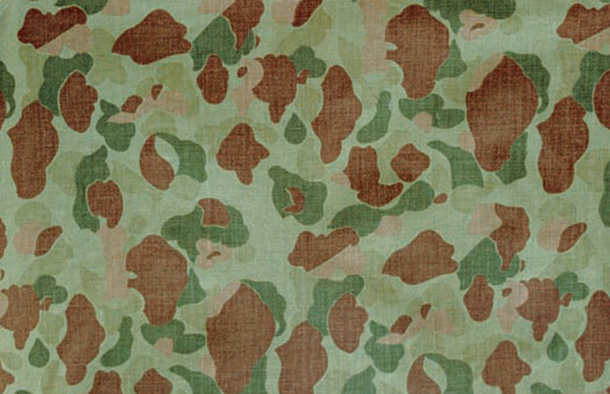
This pattern is also known as Frog Skin. (Image courtesy of Wikimedia Commons)
The South Pacific was a much different battleground than Europe, and it required a different pattern. It was adopted by duck hunters through the sixties all the way up to the nineties, but its solid colored background and large splotches of color were designed to mimic the Pacific theater of war.
🔶 ERDL 🔶

ERDL gave way to US Woodland Camo. (Image courtesy of Wikimedia Commons)
Military advancements only sped up after WWII, and in 1948, a general forest camo was born. Significantly, the ERDL pattern would become the precursor for most every military pattern to come over the next fifty years.
🔶 US Woodland 🔶

The zoomed in version of ERDL. (Image courtesy of Wikimedia Commons)
This is by far the most reproduced and utilized camo pattern in history. Nearly a quarter of the world’s militaries still use this pattern.
🔶 Chocolate Chi 🔶

A popular desert camo pattern. (Image courtesy of Wikimedia Commons)
Chocolate chip camo is real! We didn’t make this up. This desert pattern utilizes black chocolate chip-like spots to mimic rocks on a landscape.
🔶 Splinter 🔶

The Germans long forgotten camo pattern. (Image courtesy ofWikimedia Commons)
The Luftwaffe got a design on the list, even if it looks like an Atari game. This pattern was abandoned after WWII, though it is rumored that ET is stuck somewhere in one of these designs.
🔶 Multicam 🔶

Easily the most popular camo brand on the market. (Image courtesy of Wikimedia Commons)
This is an incredibly popular camouflage design that extends way beyond military and hunting applications. Today, it's as much a fashion choice as it is a camouflage.
🔶 CADPAT MARPAT 🔶

This is the digital camo pattern. (Image courtesy of Wikimedia Commons)
The Canadian military created the first ever digital camo pattern, and then the U.S. Marines basically stole the idea.
Our M4 CBRN Military Poncho is wrapped in MARPAT or Serbian Digital Camo.
Who Are the Camouflage Innovators of Today?
Allegiance to camo patterns can become something like a religious war. Don’t tell Mr. Real Tree that your Mossy Oak is a better product. With so many patterns and brands, it can be hard to choose the right one for you. So, what really sets camo patterns apart? How different are they from one another?
One thing to note is that they are proprietary, so whether you are hiding from ducks in a blind or zombies in the woods after a nuclear apocalypse, the people who designed your camouflage take the patterns very seriously. It’s literally an art.
RealTree Edge
The Real Tree Edge pattern is like artwork. (Image courtesy of Kings Camo)
The Real Tree concept is pretty straightforward. While many camo patterns were literal patterns designed to overlap colors and shapes which helped to break up the human outline, RealTree took a different angle and decided to break up that human shape using, well, real trees!
Primarily their pattern consists of things like branches, bark, pine branches, browned fall leaves and thickets. Real Tree might be the best camouflage you can buy for ground blind hunting.
RealTree Edge has taken this whole concept even further with an extremely busy set of patterns that makes a hunter blend in even at close range.
Crye Precision
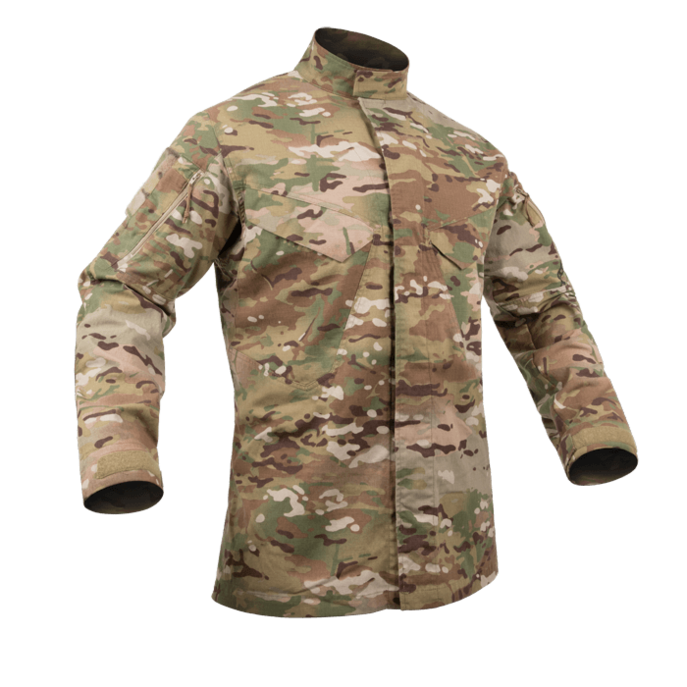
The clean Crye Precision camo pattern is a beauty. (Image courtesy of Crye Precision)
You can find the Real Tree pattern on the backs of hunters and even on hangers at your local Walmart. Crye Precision camo, on the other hand, is built for the battlefield and the tactical grayman. Somebody who is gonna strap on a MIRA CM-7M might favor this war tested camo pattern.
Crye Precision gear is made in America, and they don’t get all philosophical about their camo patterns. From compact assault ghillie suits to gray man style tactical outerwear, Crye has a lot of offerings.
Crye Precision offers environment specific camo that can cover you in desert, woodland, or snow covered environments. It’s all top quality stuff with an American made price tag, too. If you are on a budget then Crye Precision is not the place to build out your doomsday wardrobe.
Mossy Oak Obsession
When you hunt turkeys, you are on the ground. Most of the time with your back against a big wide hickory or oak. The camo you choose is essential, because turkeys have incredible eyesight, and they can move quietly and quickly when threatened. Then your hunt is over.
While it is likely sacrilege to make such a statement, the bottom line is that Obsession by Mossy Oak is a more vibrant real life camo pattern with greater depth and shadow than Real Tree. The concept is much the same with vibrant, even shining, green oak leaves, pine branches with needles, vines like honeysuckle, browning leaves, and barks.
Mossy Oak has a slew of different camo patterns that they offer up to hunters and outdoorsmen. The Obsession pattern is the ultimate design for up close and personal hunts. This is not the stuff you wear when you are glassing deer or elk in the west. Obsession is all about those dense and diverse eastern woodlands.
Hiding from Whitetails

Camouflage in tall grass can be incredibly effective. (Image courtesy of MIRA Safety)
These days, the majority of camo gear is worn by hunters–and their toddlers. There is something about slapping on that first camo article of clothing as early as possible in a hunters family. It’s a sort of Simba moment for the outdoorsmen of America.
My son, everything the light touches...has a camo pattern.
While scent and wind play a crucial role in luring the gray ghosts within striking distance, there is no doubt that the right camo pattern can make all the difference. You can watch as the forest forgets you’re there, posted up against a large oak tree and wrapped in RealTree Edge.
The creatures come back to life and the challenge of stillness–the endurance of merely being–is all that stands between you and the opportunity to take that perfect shot.
Hiding from Humanity

Snow camo can be incredibly deceptive. (Image courtesy of MIRA Safety)
Outside of military operations, it is rare that you will find yourself hiding from humanity. Things have gone terribly wrong if you are squatting in thickets and hiding from another person, with the exception of something like an afternoon of airsoft or paintball.
As effective as modern camouflage is, it is powerless against thermal vision. Thermal vision equipped police drones are a thing now. As you can imagine, the tech gets better further up the three letter agency ladders. Camo deceives the eyes, but it does nothing to conceal your body's heat signature.
If you are hiding from humanity, camo is only going to work against people who don’t have the ability to detect your body’s heat. Camo can be a great help in escaping standard night vision as this tech relies on light rather than heat.
Let’s hope that hiding from humanity remains merely a game, larping as tactical survivors on the airsoft battlefield.
Hiding Things from Humanity
Now, hiding things from humanity is just a way of keeping them secure. Property crime was up almost 10% in 2022, according to the FBI. There is no denying that people like things, and some people like taking others things for themselves.
In the prepping world, it is pretty common to hide things like survival caches. A small hot tent wrapped around a camping wood stove can be sealed up in a larger camo tarp creating what is basically a stow away bug out location.
Hiding things like vehicles and cabins can all be achieved by using the visual distortion of a large camo tarp or netting.
Maybe Not Hiding at All

Camo in fashion took it out of the woods and off the battlefield. (Image courtesy of Unsplash)
How did we turn patterns designed for concealment into a fashion statement? Was fashion camo an inevitable part of our desire to turn the world on its head? There is no denying that we love to rattle the norms until they are virtually concussed.
Now, we can find patches of camo woven into everything from NFL hoodies, to bedding, to lingerie. We use our camo to signal that we appreciate the outdoors or perhaps that there is a militant edge to our endeavors.
Final Thoughts on Camo Patterns

This man’s weapon is also camouflaged. (Image courtesy of Unsplash)
The burden of our digital ball and chain seems to be eased when we get outside and spend time with nature. That means different things to different people. A wildlife photographer can spend as much time in the field, wrapped in camo, as any hunter without ever firing a shot.
Foraging is a great excuse to practice a skill as old as humanity while donning some camo and enjoying nature, too.
The doomer side of the brain might also question the importance of camo given our proximity to warfare. Shhh. Who is that at the door? Is it WWIII rapping or the New American Civil War? You might want to read up on urban camouflage if you prefer this line of thinking.
Camouflage shares the fate of so many other incredible military inventions. At first, we are amazed by it, hungry for it, yet it is just out of range of the consumerist civilian claws Before long we all get a little taste. Soon after, it becomes another thing we take for granted. Maybe you have some camo sitting in your closet at home that hasn’t seen the light of day in half a decade.
Get some sun on that chocolate chip pattern! Hunting, larping, or just rocking it for the fun of it–enjoy your camo.
